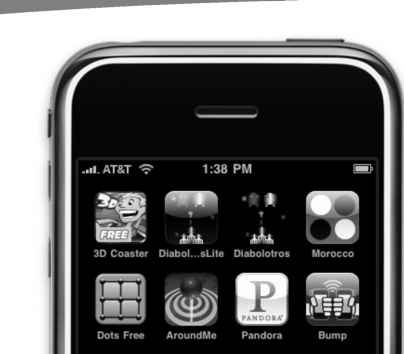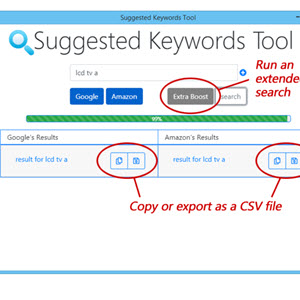Whats in an App Name
While researching the competition, you undoubtedly performed a countless number of searches within the App Store. Along the way, you discovered that the words used in an app's name and related keywords can affect its placement in App Store searches. I'll discuss how to refine your App Store display name, keywords, and description in Chapter 9, so for now let's focus on your app name. Obviously, in the App Store, you're able to add short captions to your app's display name to help ensure inclusion in relevant search results, but we won't worry about those long App Store names just yet.
Your app name is the one you will use to promote your app everywhere, both inside and outside the App Store. Coupled with its icon, your app name is a brand — one that you hope to build into a recognizable name that is both symbolic of its core function and appealing enough to be memorable. If people can't easily remember your app's name, they can't recommend it to others.
This is also the name that is listed in the very small space under your app icon when displayed on an iPhone's home screen. You've got approximately 12 characters to play with. Anything longer than that, and you risk your name being truncated (with "..."). For example, Rebisoft's Jack Nutting developed a stellar retro shooter game called Diabolotros, which makes great use of the iPhone's Accelerometer. Having grown up in the 80s, I spent a fair amount of time in the arcades playing Space Invaders, so I quickly downloaded the free Diabolotros Lite to check it out. It's an addictive, fun game, and I soon purchased the full version. I noticed that Diabolotros, at 11 characters long, displays quite nicely under the app icon on my iPhone home screen. DiabolotrosLite, however, is too long, so in order for it to fit, the name is automatically truncated to "Diabol.sLite" (see Figure 2-9).

- Figure 2-9. Try to keep your app name to 12 characters or less to avoid a truncated display on the iPhone's home screen.
Since adding the word lite or free would put most app names over the 12-character max, many developers have inserted a lite or free badge into their app icon as a visual marker for users to easily distinguish it from the full version. This alleviates the need to clutter your app name with those words.
In comparison, Digital Chocolate's 3D Rollercoaster Rush has quite a long name in the App Store, but its actual application name is shortened to 3D Coaster to ensure that it fits under the app icon on an iPhone. Luckily, users would still recognize the nickname coaster as meaning "rollercoaster." And for the free version, Digital Chocolate simply modified its app icon with a "free" badge (shown in Figure 2-9).
If you do use an abbreviated name for your application binary that's displayed on the iPhone home screen, take great care that it is not radically different from its App Store name. If the two names don't appear related in the eyes of Apple's app review team, it can be grounds for rejection from the App Store.
While Chapter 9 will be exploring app name conventions in more detail as it relates to App Store submissions, the point I'm trying to make here is that you need to think about these issues in advance when you're deciding upon your app name. Take extra care not to use long words that can't be broken down into nicknames or abbreviations. Supercalifragilistic is a memorable word but impossible to trim into a 12-character app name.
So now that you've figured out your length limitation, what would make for a good name? Finding the perfect name can be very challenging, but it's worth spending the time to get it right. In previous App Store searches, app names that included relevant keywords ranked well in the search results, but don't get too caught up with trying to integrate keywords into your app name. Remember, your app's name in the App Store can be much longer with a keyword-laden caption, so you should concentrate primarily on creating a name that's unique and memorable.
Although a name like Parked Car Locator is very descriptive, is rich with keywords, and can be easily shortened to the 11 -character "Car Locator" when needed, it's probably too generic to be registered as a trademark. Since U.S. trademark law prevents the trademark ownership of common words that describe a service or function—common words that other companies need to be able to use to describe similar things—it would be very difficult to legally protect a name like Parked Car Locator.
Instead, try coming up with something a little more creative. To prevent getting lost in the forest, travelers would often place markers on branches or leave a trail of breadcrumbs so that they could find their way back home. Since finding your way back to your parked car involves a similar strategy, you might want to play around with a cute app name like Breadcrumbs, which is only 11 characters long. To ensure placement in relevant search results within the App Store, you could pack your app submission with important keywords and even expand your App Store name to Breadcrumbs—Parked Car Locator.
If another iPhone app is using a similar name, then you'll definitely want to come up with a different name. Even if you've locked in on a name that no one else is using in the App Store, you can't stop there. You should also search the Internet and all major software directories—Google.com, MacUpdate.com, and VersionTracker.com to name a few—to check for any possible conflicts on other software platforms.
You'll also want to search the United States Patent and Trademark Office's TESS database for any filed trademarks on that name (TESS stands for Trademark Electronic Search System):
http://www.uspto.gov/main/trademarks.htm
Searching TESS in no way obligates you to file a trademark. That's something you can do later when you're ready. For now, you merely want to make sure the name is not already trademarked by another party.
And if you're planning on making your iPhone app available in multiple regional App Stores beyond your own, then you'll also want to check for registered trademarks and any usage of that name in those respective countries. For guidance on securing and protecting your application name rights internationally, you may want to consult with a trademark attorney.
Why would it matter if a Mac or Windows software product is already using that name if you only plan on using it for your iPhone app? Well, it causes brand confusion for consumers who might incorrectly assume your app is the iPhone version of the Mac or Windows software of the same name. If another software company was using that name first and can prove prior art (prior public use of the name and logo), especially if they've already registered the trademark, you'll find yourself legally vulnerable. You don't want to spend months developing your app only to receive a cease-and-desist letter from their attorneys. Even worse, if your iPhone app has become a successful best-seller in the App Store, you don't want them to sue you for trademark infringement and a percentage of your app royalties.
My intent is not to scare you but simply to make you aware of the potential land mines to watch out for when picking a unique name for your iPhone app.
This is the kind of legal safeguarding that you'll want to do for your original app name, icon, and logo, so check out the section in Chapter 3 where Michael Schneider explains the benefits and process of registering a trademark.
Continue reading here: Drawing Your Ideas on Paper
Was this article helpful?

